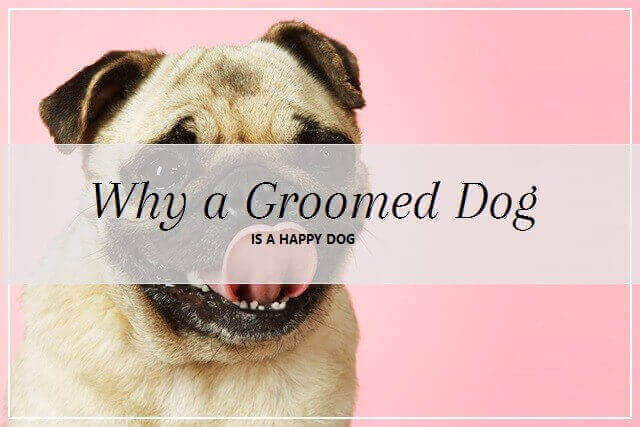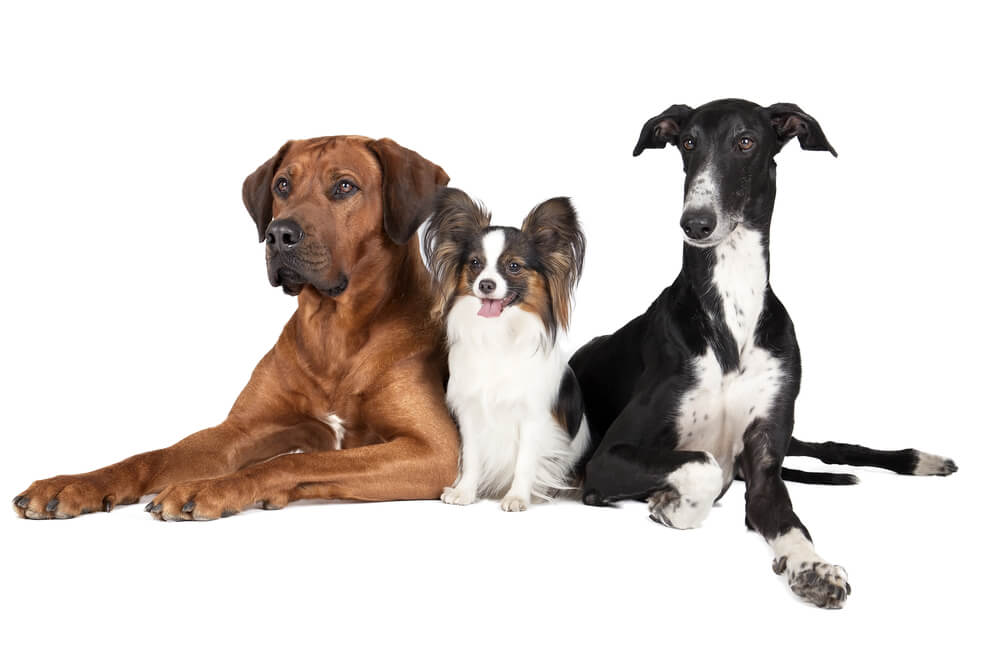Imagine going months without washing your hair, cutting your nails or brushing your teeth. Unfortunately, this is the reality for lots of dogs because their owners have not been advised on the importance of good grooming.
With busy schedules, it’s difficult for owners to keep on top of a regular grooming routine. Mats, impacted hair between the paw pads, ear problems, lumps and bumps, skin infections or irritations are just some of the things that may not be picked up, so working with a professional groomer will help keep these things in check.
GROOMING FREQUENCY
A good grooming routine is essential to the health and well- being of your dog. All dogs benefit from regular grooming whether you have a short haired breed or one with a long flowing coat. Not only does it keep coats clean and manageable it also aerates the coat ensuring healthy growth, and helps your dog regulate their body temperature. Long haired dogs and those with active lifestyles need to be groomed more frequently. How often they are groomed will depend on upon a number of factors – their breed, length of coat, the condition of the skin, general health, and how mucky your dog gets! Certain breeds need more frequent grooming than others. Check out our grooming schedule here to see how often your dog needs to be professionally groomed.
COAT
A dog’s coat does a lot more than just defining your dog’s colour. The coat serves as an insulating layer between your dog’s skin and the external environment. It protects them from the heat and sun in the summer, the cold in the winter, and from cuts and abrasions. So correct grooming practices, coat length, and coat care is essential to your dog’s ability to regulate its temperature and protect its delicate skin. Dogs have several types of hair and each type requires different levels of care. Depending on breed your dog will either have a smooth, short, silky, curly or wavy, wiry, long, corded, combination, double, or heavy coat. The growth of their hair is affected by nutrition, hormones, and change of season. Dogs normally shed hair in the early spring and early autumn. When shedding, loose hair can get trapped causing them to become tangled and matted. If not effectively brushed on a regular basis this can result in heavy matting which causes your dog pain and skin irritation. For more information on matting see our article Mat Matters.
As the growth and health of your dog’s coat and skin is heavily dependent on their diet, the better your dog’s food the better the condition of their coat and skin. Foods that are rich in essential fatty acids are particularly of benefit to your dog’s coat, so if your dog is showing signs of issues with coat or skin then their diet could be the problem. What does a healthy coat look like? The coat should be soft and relatively smooth even on short or wire-haired breeds, it should be shiny but not greasy and it should not have a strong odour. An unhealthy coat is brittle and dry with lots of loose hair, it may have a dull appearance, be greasy, have bald spots or an unpleasant smell. If your dog has an unhealthy coat do not be tempted to over-bathe as this can lead to dry skin and irritation. Speak to your vet or the professional groomer for advice on how best to address this issue. Your dog’s coat type will determine the grooming method and products required to optimise the health and performance of their coat.
SKIN
Skin disorders are amongst the most common health problems in dogs. Constant scratching, biting, or licking is usually caused by parasites, infections, allergies, stress, diet, environmental problems, or a combination of these. If not, it may just be dry skin. Regardless of the source itching is a threat to skin health. A dog’s outer layer of skin is not as thick as humans, it also has a different pH level making the skin not only delicate but susceptible to absorbing undesirables. Using products formulated for human use will disrupt your dog’s skin acid mantle creating an environment where bacteria, parasites, and viruses can grow. To protect against this never use human shampoo, soap, conditioner, or perfumes on your dog. A dog’s skin depends on the hair and oils on it to keep it in good condition. Grooming your dog regularly helps promote healthy skin and prevent the problems caused by matted hair which provides a breeding grounds for a variety of skin diseases. If you notice any abnormality in your dog’s skin, or if your dog begins to excessively scratch, lick and/or bite areas on its body you should visit your vet for an examination as soon as possible.
EARS
Cleaning your dog’s ears is an essential part of their grooming routine. All dogs should have their ears cleaned on a regular basis however some dogs need more frequent and thorough cleaning than others due to their genetic predispositions to ear infections. Dogs with long floppy ears have a lack of adequate airflow to the ear canal which can expedite an ear infection. Other dogs have an excessive amount of glands in their ear canals which produce a lot of secretions that need regular cleaning.
When we clean the ears we focus on the external ear canal as ear wax and debris can easily build up around the ridges. Never clean beyond this point in a dog’s ears, and never use a cotton bud to go down into the ear canal. If your dog has an ear infection you should visit your vet. In addition to cleansing, certain breeds also require their ears to be plucked due to them having thick hair growing in their ear canal. Poodles, Shih Tzu, and Maltese are some of the breeds that require their ears to be plucked. Care has to be taken when doing this to avoid irritation or causing pain to the dog. This is a task best left to the professional groomer.
NAILS
That click-click sound your dog makes when walking means it’s time to cut their overgrown nails. Most people get very anxious at the thought of clipping their dog’s nails especially those dogs with black nails. If your dog’s nails get too long they can break and bleed which is very painful and can result in infection. Overgrown nails can also curl backwards into the dogs pad causing serious pain and possible infection, this is typically more common in the dew claw. Nails that are too long also cause an irregular gait that leads to skeletal damage. When cutting the nail it is very important not to cut the ‘quick’ (the living part of a dog’s nail that has blood vessels and nerves running throughout) as this will cause the nail to bleed. In white nails this can be easily seen however in black nails cutting will have to be done in stages to avoid the quick. If you are not comfortable cutting your dog’s nails then you should take them to your groomer.
TEETH
Caring for your dog’s teeth is vital to their overall health and care. Many dogs show signs of gum disease by the time they are 4 years old because they haven’t been given proper mouth care. The frequency of dental scaling and polishing will depend on how quickly tartar forms on your dog’s teeth. A good home care program will reduce how often your dog’s teeth need to be professionally cleaned. You should aim to brush your dog’s teeth 3 times per week using a toothpaste formulated for dogs. Never use human toothpaste to brush your dog’s teeth. You should start this as soon as possible when your dog is young so they get used to the sensation of their teeth being cleaned. A yearly dental check up with the vet is recommended.
WHY PROFESSIONAL GROOMING
A professional groomer will have a vast selection of tools, products, and equipment specifically developed for use on our canine companions which you may not have at home. They will be skilled at clipping nails, cleaning and plucking ears, using correct bathing and brushing practices, and be able to provide the right cut to make your dog look and feel their best. Every pet parent should build a relationship with their groomer of choice as your groomer can help you care for and maintain the health of your beloved pooch.
BETWEEN PROFESSIONAL GROOMING
If your dog’s coat is dirty it is recommended you do not brush it as this can damage the coat as hair breaks easier when dry. Instead, bath your dog before brushing or schedule them a visit with their groomer. A lot of people that want to bathe their dog between visits to the grooming salon ask if they can use their own shampoo and conditioner on their dog. The answer is definitely not and here is the reason why. As mentioned above your dog’s skin has a different pH to yours so using human products can disrupt their skin’s acid mantel and create an environment where bacteria, parasites, and viruses grow on your pooch resulting in a lot of discomfort and skin problems. Always use products specially developed for use on your pooch. For more information on the importance of using the right products and advice on what to look for when purchasing products click here.
If bathing your dog at home remember to use cool to lukewarm water. A dog’s skin is thinner than ours and their body temperature is a degree higher so they feel the heat much easier than us. If your dog starts panting when you are washing them the water temperature is too high. The same applies for drying. Do not use a hairdryer on a high heat setting, always use the cool setting and use from a distance. Human hairdryers were not designed for use on dogs so if unsure towel dry your dog and let dry naturally before leaving them to go outside (unless it is very warm outside). If unsure of how to dry your dog speak with your groomer.
If trimming your dog’s nails at home do so after a bath when you dog is wet as the nails will be softer and this can help prevent splitting. Don’t forget to check for the quick and do not cut into it. Again if unsure leave this task to your groomer.


